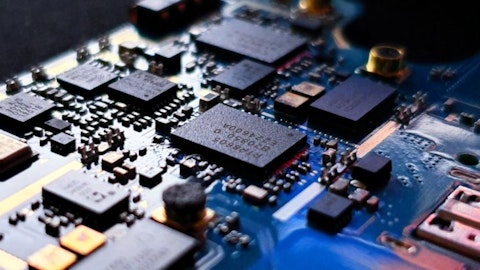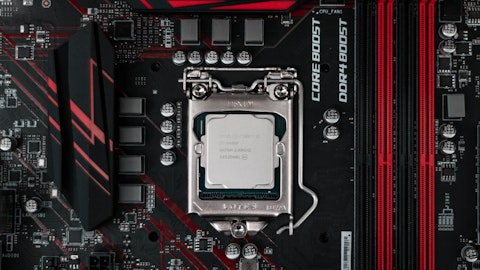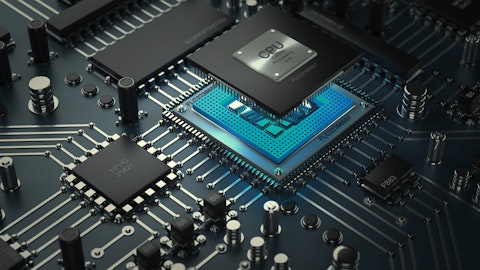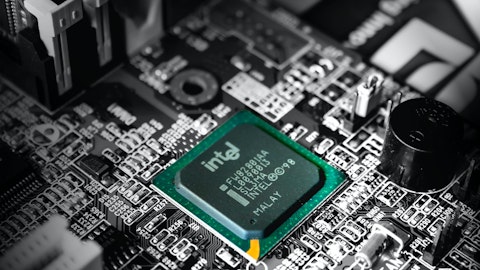Microchip Technology Incorporated (NASDAQ:MCHP) Q3 2023 Earnings Call Transcript February 2, 2023
Operator: Good day everyone, and welcome to Microchip’s Third Quarter Fiscal 2023 Financial Results Conference Call. As a reminder, today’s call is being recorded. At this time, I would like to turn the call over to Mr. Eric Bjornholt, our CFO. Please go ahead, sir.
James Eric Bjornholt: Thank you and good afternoon, everyone. During the course of this conference call, we will be making projections and other forward-looking statements regarding future events or the future financial performance of the company, I wish to caution you that such statements are predictions and that actual events or results may differ materially. We refer you to our press releases of today as well as our recent filings with the SEC that identify important risk factors that may impact Microchip’s business and results of operations. In attendance with me today are Ganesh Moorthy, Microchip’s President and CEO; Steve Sanghi, Microchip’s Executive Chair; and Sajid Daudi, Microchip’s Head Of Investor Relations. I will comment on our third quarter financial performance.
Ganesh will then provide commentary on our results and discuss the current business environment as well as our guidance. And Steve will provide an update on our cash return strategy. We will then be available to respond specific industrial and analyst questions. We are including information in our press release and on this conference call on various GAAP and non-GAAP measures. We have posted the full GAAP to non GAAP reconciliation on the investor relations page of our website at www.microchip.com and included reconciliation information in our press release, which we believe you will find useful when comparing our GAAP and non-GAAP results. We have also posted a summary of our outstanding debt and our leverage metrics on our website. I will now go through some of our operating results including net sales, gross margin and operating expenses.
Other than net sales, I will be referring to these results on a non-GAAP basis, which is based on expenses prior to the effects of acquisition activities, share-based compensation and certain other adjustments that described in our press release and in the reconciliations on our website. Net sales in the December quarter were $2.169 billion, which was up 4.6% sequentially. We have posted a summary of our GAAP net sales by product line and geography on our website for your reference. On a non-GAAP basis, gross margins were a record at 68.1%, operating expenses were 20.6% and operating income was a record 47.5%. Non-GAAP net income was a record $863.7 million, non-GAAP earnings per diluted share was a record $1.56 and at the high-end of our guidance range.
On a GAAP basis in the December quarter, gross margins were a record at 67.8%, total operating expenses were $659.2 million and included acquisition intangible amortization of $167.4 million, special charges of $6.5 million and $0.3 million of acquisition related and other costs and share-based compensation of $37.1 million. GAAP net income was a record $580.3 million, resulting at a $1.4 in earnings per diluted share. As compared to a year ago quarter, our December quarter GAAP tax expense was impacted by a variety of factors, notably the tax expense recorded as a result of the capitalization of R&D expenses for tax purposes. Our non-GAAP cash tax rate was 11.9% in the December quarter. We now expect our non-GAAP cash tax rate for fiscal ’23 to be about 11% exclusive of the transition tax and any tax audit settlements related to taxes accrued in prior fiscal years.
A reminder of what we communicated over the past couple quarters. Our fiscal ’23 cash tax rate is higher than our fiscal ’22 tax rate for a variety of factors including lower availability of tax attributes such as net operating losses and tax credits, as well as the impact of current tax rules requiring the capitalization of R&D expenses for tax purposes. We’re still hopeful that the tax rules requiring companies to capitalize R&D expenses will be pushed out or repealed. If this were to happen, we would anticipate about a 300 basis points favorable adjustment to Microchips non-GAAP tax rate in future periods. Our inventory balance at December 31, 2022 was $1.165 billion. We had 152 days of inventory at the end of the December quarter, which was up 13 days from the prior quarters level.
We’ve increased our raw materials inventory to help protect our internal manufacturing supply lines. We are carrying higher work in progress to help maximize the utilization of constraint equipment, as well as to position ourselves to take advantage of new equipment installations, which should really bottlenecks. We are investing in building inventory for long lived high margin products whose manufacturing capacity is being end of life by our supply chain partners. We need to take actions to help ensure that our supply lines can feed growth beyond what we expect in the March 2023 and June 2023 quarters and our reported days of inventory is a backward looking indicator. As gross margins rise, the effective days of inventory for the same physical inventory rises.
And with every 100 basis points of gross margin growth it creates approximately three incremental days of inventory. Inventory at our distributors in the December quarter was at 22 days, which was up 3 days from the prior quarters level. Our cash flow from operating activities was a record $1.278 billion in the December quarter. Included in our cash flow from operating activities was $385 million of long-term supply assurance receipts. We are going to adjust these items out of our free cash flow to determine the adjusted free cash flow that we will return to shareholders as these payments will be refundable over time as purchase commitments are fulfilled. Our adjusted free cash flow was $751.6 million and 34.6% of net sales in the December quarter.
As of December 31, our consolidated cash and total investment position was $288.9 million. We paid down $719.1 million of total debt in the December quarter, and our net debt was reduced by $701.2 million. Over the last 18 full quarters since we closed the Microsemi acquisition and incurred over $8 billion in debt to do so, we have paid down almost $6.2 billion of the debt and continue to allocate substantially all of our excess cash beyond dividends and stock buyback to bring down this debt. Our adjusted EBITDA in the December quarter was a record at $1.106 billion and 51% of net sales. Our trailing 12-month adjusted EBITDA was also a record at $4.051 billion. Our net debt to adjusted EBITDA was 1.56 at December 31, 2022, down from 1.84 at September 30, 2022 and down from 2.58 at December 31, 2021.
Capital expenditures were $141.3 million in the December quarter. Our expectation for capital expenditures for fiscal year 2023 is between $525 million and $545 million, as we continue to take actions to support the growth of our business and ramp our manufacturing operations accordingly. We continue to prudently add capital equipment to maintain grow and operate our internal manufacturing operations to support the expected long-term growth of our business. We expect these capital investments will bring gross margin improvements to our business and give us increased control over our production during periods of industry wide constraints. Depreciation expense in the December quarter was $55.3 million. I will now turn it over to Ganesh to give us comments on the performance of the business and the December quarter as well as our guidance for the March quarter.
Ganesh?
Ganesh Moorthy: Thank you, Eric, and good afternoon, everyone. Our December quarter results were well above the midpoint of our revenue guidance marked by our disciplined execution as well as our resilient end markets. Net sales grew 4.6% sequentially and 23.4% on a year-over-year basis to achieve another all time record are $2.17 billion. The December quarter also marked our ninth consecutive quarter of growth. Non-GAAP gross margins came in above the high-end of our guidance at a record 68.1%, up 38 basis points from the September quarter and up 202 basis points from the year ago quarter. Non-GAAP operating margin also came in above the high-end of our guidance at a record 47.5%, up 62 basis points from the September quarter and up 283 basis points from the year ago quarter.
Due to a rapid increase in net sales over the last 2 years, operating expenses at 20.65% were 185 basis points below the low end of our long-term model range of 22.5% to 23.5%. Our long-term operating expense model will continue to guide our investment actions to drive the long-term growth, profitability and durability of our business. Our consolidated non-GAAP diluted earnings per share was at the high-end of our guidance at a record $1.56 per share, up 30% from the year ago quarter. Adjusted EBITDA at 51% of net sales and adjusted free cash flow at 34.6% of net sales for both very strong in the December quarter, continuing to demonstrate the robust cash generation capabilities of our business. As Eric mentioned, we have excluded $385 million of long-term supply assurance payments made by customers from our adjusted free cash flow calculation.
Since these payments are refundable when customers fulfill their purchase commitments. Net debt declined by $701.2 million, driving our net leverage ratio down to 1.56x, exiting the December quarter. During the December quarter, we returned $409.8 million to shareholders in dividends and share repurchases, representing 60% of the prior quarters free cash flow. We expect to get below 1.5x net leverage by the end of the March quarter. And as Steve will share with you later, the Microchip Board has decided to increase the rate at which capital will be returned to shareholders starting in the June quarter. My heartfelt gratitude to all our stakeholders who enabled us to achieve these outstanding results and especially to the worldwide Microchip team whose tireless efforts and strong sense of ownership are what enabled us to navigate effectively in the midst of turbulent times.
Taking a look at our net sales from a product line perspective, our microcontroller net sales were sequentially up 3.5% in the December quarter, and set another all time record. On a year-over-year basis, our December quarter microcontroller net sales were up 25.6%. Microcontrollers represented 56.3% of our net sales in the December quarter. Our analog net sales were sequentially up 5.9% in the December quarter, and also set an all time record. On a year-over-year basis, our December quarter analog net sales were up 21.2%. Analog represented 28% of our net sales on the December quarter. In the December quarter, our FPGA net sales also achieved a new record. While our overall business remains strong in the December quarter, the consumer appliance and market was weak as was our overall business in China.
Our China business was initially impacted by COVID lockdowns and then subsequently impacted by the rapid transmission of COVID when lockdowns were lifted. Both actions adversely impacted our customers operations during the December quarter, resulting in inventory of many customers and distributors being higher than normal. In response to the weaker business environment in China, and a small but increasing number of other customers who have inventory and requested push outs, we took action in the December quarter to delay or redirect some shipments and plan to do more of the same in the March quarter. This is designed to reduce customer and channel inventory overbuilt, but will also increase the inventory on our balance sheet in the near-term.
In the medium term, we expect this will give us a better chance to achieve a soft landing and position us well to respond to a stronger demand growth as the macro environment improves. As a result of the uncertain macro environment, and the multiple quarters with a backlog on our books, most of which is non cancelable, our bookings have slowed down as we expected. Given the circumstances we view the bookings slowdown as a positive which will serve to preserve the quality of new backlog that gets placed. Our unsupported backlog which represents backlog customers wanted shipped to them in the December quarter, but which we could not deliver in the December quarter remain well in excess of the actual net sales we achieved. Unsupported backlog did declined slightly for the first time in nine quarters.
And we are continuing to work hard to further reduce our unsupported backlog, as well as our lead times to more manageable levels. While we have seen an increase in requests to push out or cancel backlog, these requests remain a small fraction of the very large backlog we have over multiple quarters, and hence they have not had a material effect on our business. Despite supply gradually improving, we expect to have supply constraints from much of 2023. However, in order to achieve a more healthy and sustainable business environment, we are driving to bring average lead times down to 26 weeks or less by the time we get to the second half of 2023. And we will be publishing a customer letter to this effect shortly. We believe there are three reasons why Microchip’s business is demonstrating more resilience in the midst of the weakness seen by some other semiconductor companies.
First, on the demand side, the industrial, automotive, aerospace and defense, data center and communications infrastructure end markets, which make up approximately 86% of our net sales remain solid. The consumer end market, which is about 14% of our net sales is experiencing some weakness, but it’s dominated by home appliances which are comparatively more resilient. There are some signs that the data center end market could see some headwinds in 2023. Although our business remains strong, based on the market share gains we have had. And our overall demand remains quite durable, because of the end market mix we have consciously gravitated towards over the years. Second, on the supply side, a vast majority of our products are built on specialized technologies requiring trailing edge capacity.
This is the capacity that has been most constrained over the last 2 years, which still remains constrained and where there was less opportunity to over ship to consumption. And last but not least, our laser focus on organic growth through total system solutions and higher growth mega trends for multiple years is giving us increased design momentum, farther share gains and a result in revenue tailwind. If you review Microchip’s peak to trough performance through the business cycles over the last 15 plus years, you will observe a robust and consistent cash generation, gross margin and operating margin results. The investor presentation posted on our IR website has details of our performance through the business cycle. We remain cautiously optimistic about navigating to a soft landing for our business and expect our cash generation gross margin and operating margin to once again demonstrate consistency and resiliency through the cycle.

Photo by Yogesh Phuyal on Unsplash
Last quarter, we mentioned that Microchip was in the early stages of considering building a 300 millimeter U.S based fab for specialized trailing edge technologies. After a detailed analysis, we have concluded not to move forward with this project. And that our business objectives would likely be better achieved through our relationships with our foundry suppliers with lower execution risk, and a better return on invested capital. The CHIPS Act is already making a positive impact on our business through the investment tax credit, which started on January 1. And with impending capacity expansion grants that we will be seeking with several of our U.S semiconductor factories. We believe that CHIPS Act is good for the semiconductor industry and for America, as it enables critical investments, which will help even the global playing field while being strategically important for American economic and national security.
Now, let’s get into the guidance for the March quarter. Our backlog for the March quarter is strong, and we have more capacity improvements coming into effect. However, we are also taking active steps to help customers with inventory positions to selectively push out some of their backlog. Taking all the factors we have discussed on the call today into consideration, we expect our net sales for the March quarter to be up between 1% and 4% sequentially. Further, we expect sequential net sales growth again in the June quarter. At the midpoint of our net sales guidance, our year-over-year growth for the March quarter would be a strong 20.6%. We expect our non-GAAP gross margin to be between 68.1% and 68.3% of sales. We expect non-GAAP operating expenses to be between 20.6% and 20.8% of sales.
We expect non-GAAP operating profit to be between 47.3% and 47.7% of sales. And we expect a non-GAAP diluted earnings per share to be between $1.61 per share and $1.63 per share. At the midpoint of our earnings per share guidance, our year-over-year growth for the March quarter would be a strong 20% despite a much higher tax rate than the year ago quarter. Finally, as you can see from our December quarter results and our March quarter guidance, our Microchip 3.0 strategy, which we launched 15 months ago, is firing on all cylinders as we continue to build and improve what we believe is one of the most diversified, defensible, high growth, high margin, high cash generating businesses in the semiconductor industry. Our Board of Directors and leadership team operate just as long-term owners of the business would thoughtfully making the key investments in people, technology, capacity, culture and sustainability required to thrive in the long-term.
While being prudent, pragmatic and nimble about whatever short-term adjustments may be required. We are confident we will effectively navigate through whatever macro business challenges may unfold in 2023. Let me now pass the baton to Steve to talk more about our cash return to shareholders. Steve?
Stephen Sanghi: Thank you, Ganesh, and good afternoon, everyone. I would like to reflect on our financial results announced today and provide you further updates on our cash return strategy. Reflecting on our financial results, I continue to be very proud of all employees of Microchip that have delivered another exceptional quarter, while making new records in many respects, namely record net sales, record non-GAAP gross margin percentage, record non-GAAP operating margin percentage, record non GAAP EPS and record adjusted EBITDA and all that in a continuing challenging supply environment. The Board of Directors announced an increase in the dividend of 9.1% from last quarter to 35.8 cents per share. This is an increase of 41.5% from the year ago quarter.
During the last quarter, we purchased $229.5 million of stock in the open market. We also paid out $180.3 million in dividends. Thus the total cash return was $409.8 million. This amount was 60% of our actual free cash flow of $682.9 million during the September 2022 quarter. Our pay down of debt as well as record adjusted EBITDA drove down our net leverage at the end of December 2022 quarter to 1.56 from 1.84 at the end of September. Ever since we achieved an investment grade rating for a debt in November 2021 and pivoted to increasing our capital return to shareholders, we have returned $1.867 billion to shareholders through December 31, 2022 by a combination of dividends and share buybacks. In the current March quarter, we will use the adjusted free cash flow from the December quarter to target the amount of cash returned to shareholders.
The adjusted free cash flow excludes $385 million that we collected from our customers for long-term supply assurance payments. These payments are refundable when customer fulfill their purchase commitments. The adjusted free cash flow for December quarter was $751.6 million. We plan to return 62.5% or $469.8 million of that amount to our shareholders. The dividend expected to be approximately $196 million, and the stock buyback expected to be approximately $273.8 million. We also want to provide guidance for a planned cash return to shareholders beyond this quarter. We expect our net debt leverage at the end of March quarter to be less than 1.5. Therefore, our Board of Directors decided that beginning with the June quarter, we will accelerate the cash return to shareholders.
We laid out a strategy for our cash return to shareholders at an analyst and investor day in November 2021. We began with returning 50% of the free cash flow of the prior quarter and increasing it by 2.5 percentage points every quarter. With these increases, we’ll be returning 62.5% of last quarter’s adjusted free cash flow to investors this quarter. Beginning in June quarter, we expect to double the rate at which we are increasing the percentage free cash flow return to shareholders. In other words, in June quarter, we expect to return 67.5% of our adjusted free cash flow from March quarter. Then in September quarter, we expect to return 72.5% of adjusted free cash flow from the June quarter. And so on, 5 percentage point increase every quarter.
At this rate, we would approach 100% return of our adjusted free cash flow in about eight quarters. We realized that we’re still getting a debt burden of $6.62 billion in a rising interest rate environment as some of our debt matures, we will likely be renewing it at a higher interest rate than we are currently paying on such debt. Our strategy of accelerating our cash return to shareholders over several quarters would help us pay down some additional debt and lower our debt service costs. With that, operator, will you please call for questions?
See also 25 Strongest Countries in Europe by Military Power and 10 Most Advanced Battery Technologies.
Q&A Session
Follow Microchip Technology Inc (NASDAQ:MCHP)
Follow Microchip Technology Inc (NASDAQ:MCHP)
Operator: Our first question comes from the line of Toshiya Hari with Goldman Sachs. Please proceed.
Toshiya Hari: Hi, good afternoon. Thank you so much for taking the question. I had a question on the pricing environment. In calendar ’22, you grew your business about 25%. What percentage of that was pricing versus volume, and as you look ahead to calendar ’23. considering the demand backdrop, considering potential price hikes from some of your foundry partners, how do you think about pricing and how do you see pricing play out and any implications for your margin profile in calendar ’23. Thank you.
Ganesh Moorthy: So the price increases in 2022, we’re — at various stages, and different based on customer what contractual agreements we had with them. Our philosophy is the price increases are there to cover the cost increases that we saw in 2022. So we don’t have a nice, easy breakout of what was cost driven — price driven increase versus product shipment increases. And that is a component of both obviously. The intensity of cost increases we’re seeing in 2023 are less than what they were in 2022. And we have not really made any judgment yet on price increases for this calendar year. Our intent would be that at some point, we’ll look at it, and again have the same philosophy that we want to make sure that the cost increases are covered in any price increases we make.
Pricing for us is a strategic exercise. It is intended to make sure that customers get comfort in being able to design, proprietary designs that they’re going to run with us for a long time. It is not a tactical exercise to be able to maximize either the price or the revenue or the profits that come from it. Thank you.
Operator: Our next question comes from the line of Vivek Arya with Bank of America. Please proceed.
Vivek Arya: Thanks for taking my question. Ganesh, I’m curious, do you think the share gains that you’re seeing when I compare your sequential or year-on-year growth in calendar Q1 versus your peers. Is that a cyclical thing? Is that a structural thing, because many of your peers also have lower consumer exposure. They have high industrial, automotive exposure, and many of them have guided sales down, yet you’re guiding it up in March and suggesting that they could grow again in June. So I’m curious how much of this is just a cyclical issue where you just had a difference and when supply was available? Or is it really you’re gaining share or there is something more structural and you can maintain this kind of market share gain advantage over time? Thank you.
Ganesh Moorthy: Yes, as I mentioned, in the three categories of what we believe is differentiating our results, a part of it, which is structural is what we have done for multiple years on how do we grow organically? How does the total system solutions approach which is a huge amount of work across the company come in and then it takes time for it to pay off. That’s been happening for multiple years. How do we focus on higher growth opportunities from a market megatrends standpoint. Those are all we believe, unique growth drivers for Microchip, and are in fact structural growth that is being built into what our long-term growth will be.
Vivek Arya: Thank you.
Ganesh Moorthy: Thanks, Vivek.
Operator: Our next question comes from the line of Gary Mobley with Wells Fargo Securities. Please proceed.
Gary Mobley: Hey, guys. Thanks for taking my question. I realized that you got out of the business of providing some estimation as to how many quarters in a row you may be able to grow sequentially into the future. But since you did comment on the June quarter, I was hoping that maybe you can share with us the magnitude of the sequential increase you might see in June and then perhaps may this sequential growth continue beyond the June quarter?
Ganesh Moorthy: Firstly, we’re not trying to guide anything beyond the June quarter. And for June, like we did in prior quarters, we’re giving you a directional expectation that we have, but not an absolute expectation that we have. And we’ll get to that when we get to the May conference call. But for now, we feel confident we can grow in the June quarter on top of the guidance we’re providing in the March quarter.
Gary Mobley: Thank you. Thank you, Ganesh.
Ganesh Moorthy: Thanks, Gary.
Operator: Our next question comes from the line of Joshua Buchalter with Cowen & Company. Please proceed.
Joshua Buchalter: Hey, guys. Thanks for taking my questions. This is Josh Buchalter on behalf of Matt Ramsay. I wanted to ask you about the capital return program. I think some may have expected more binary event when you hit the leverage target, but you’re taking the more gradual approach. You called out the rate environment. Can you walk us through sort of why the decision to more gradually take it up? And then also is there I guess an intermediate target leverage where you would stop doing debt repayments altogether and just do 100% repurchases and dividends. Thank you.
James Eric Bjornholt: So what Board has decided is that given $6.62 billion still owing on the debt, and some of that debt, I think at least $2 billion of that debt have an interest rate of below 100 bps. And when that comes up from maturity, we will be renewing it. If we were renewing it today, it will be over 5%. So in that kind of current environment and interest rates are still rising, the Board decided to not go to 100% cash return right away today. They decided to do that over eight quarters. We double the rate at which we are increasing the cash return, we were increasing it like 60%, going to 62.5%, going to 65%. And what we have said is now we will go up 500 bps of the quarter. So current quarter 62.5%, next quarter, 67.5%, then 72.5% and 77.5%. At that rate, I think in seven quarters or so will be 97.5% and then go to 100%. I think that’s a more reasonable approach to pay down some more debt along in the next eight quarters.
Ganesh Moorthy: Joshua, if I will add to it, I think, circumstances have changed from 2021 when interest rates were very low, money was freely available to where we are, and we have to adjust as the circumstances change. And that’s what the Board in its deliberation had to think about, and decided in terms of how we’re going to go forward. We’re absolutely committed to what we said. But we’re going into glide slope, that is different today given what we know is the circumstances today.
Joshua Buchalter: Thanks for the color and congrats on the results.
Ganesh Moorthy: Thank you.
Operator: Our next question comes from the line of Raji Gill with Needham & Company. Please proceed.





